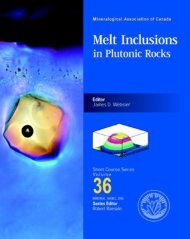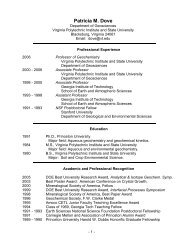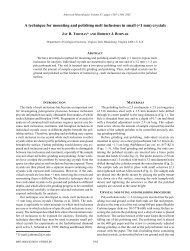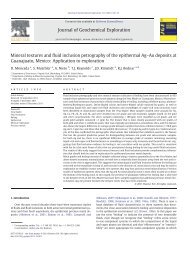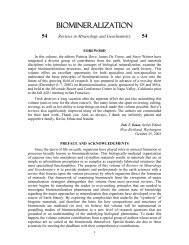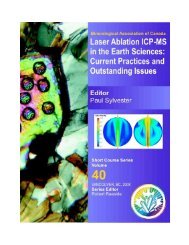Biomineralization Within Vesicles: The Calcite of Coccoliths
Biomineralization Within Vesicles: The Calcite of Coccoliths
Biomineralization Within Vesicles: The Calcite of Coccoliths
Create successful ePaper yourself
Turn your PDF publications into a flip-book with our unique Google optimized e-Paper software.
208 Young & Henriksenperhaps invariably, euhedral rhombohedra. <strong>The</strong> crystallites are <strong>of</strong>ten referred toas hexagonal, but this is more accurately a description <strong>of</strong> the arrangement <strong>of</strong> thecrystallites.3. <strong>The</strong> crystallites do not interlock or intergrow. This is very nicely shown by theacid etched specimens (Fig. 10C), but again observations on numerous otherspecimens show it is a general pattern.4. <strong>The</strong> crystallites are each enveloped in an organic coating. <strong>The</strong> best evidence forthis comes from the acid etched specimens. Presumably, this is similar to thepolysaccharide coatings <strong>of</strong> heterococcoliths. In SEM the holococcolithcrystallites <strong>of</strong>ten have rough surfaces rather than smooth crystal faces; this maybe due to these organic coatings.5. <strong>The</strong> crystal faces <strong>of</strong> the crystallites are clearly aligned across large areas <strong>of</strong> theholococcoliths; thus the crystallographic orientation <strong>of</strong> the crystallites iscompletely controlled.6. Although all holococcolith crystallites are broadly similar, there are consistentdifferences in crystallite size and surface morphology, both between species andoccasionally even over different parts <strong>of</strong> a single holococcolith. This is shown toa limited extent by the S. anthos holococcoliths, where there is a field <strong>of</strong> larger,less regular crystallites at the base <strong>of</strong> the tube. Note also that the crystallites <strong>of</strong> C.pelagicus holococcoliths (Fig. 10F) are significantly larger (~0.2 µm across) thanthose <strong>of</strong> the other figured species (which are ~0.1 µm across).7. Crystallite arrangement patterns are clearly controlled by the biomineral system,varying between species and between parts <strong>of</strong> single holococcoliths. <strong>The</strong> mostcommon arrangement is a hexagonal fabric (Figs. 10A−D), in which rhombohedralcrystallites are arranged edge to edge, with their c-axes directed perpendicular tothe surface. This may be modified into a hexagonal mesh fabric, in which one infour crystallites is missing, giving a sieve-like appearance (Fig. 10E). Other lessregular variations on this basic pattern occur. Rhombohedral array fabrics (Fig.10F) are distinctively different; the rhombohedra are arranged with the c-axesoblique to the surface, and the crystallites are aligned face to face.All these features tend to emphasize the basic observation that holococcolithbiomineralization is a remarkably highly regulated process with the final morphology aproduct <strong>of</strong> biologically controlled mineralization, even if it occurs outside the cellmembrane. <strong>The</strong>re is, however, still essentially no model for how the growth regulationoccurs. Crystallite growth does not show the remarkable sculpting <strong>of</strong> heterococcolithcrystal units, but the regular termination <strong>of</strong> growth such that each crystallite is <strong>of</strong> regularsize and shape is striking. This could be a product <strong>of</strong> biologically mediated growth;calcite rhombohedra <strong>of</strong> uniform size can be produced in vitro with surface inhibitors(Henriksen unpubl. data).Control <strong>of</strong> crystallite orientation is difficult to understand, since the dispersednucleation necessary to produce all the crystallites and the layered structure in somespecies makes it difficult to envisage how or where an organic template precursor couldoccur. An alternative that should be considered is that the crystallites are initiallyrandomly oriented and are aligned by the coccolith shaping system. It is even conceivablethat the crystallites are not formed in situ but are delivered preformed to the growingholococcolith.It is frustrating that biomineralization in holococcoliths is so poorly understood andthat it has not been possible to make any direct observations <strong>of</strong> the growth process, not



